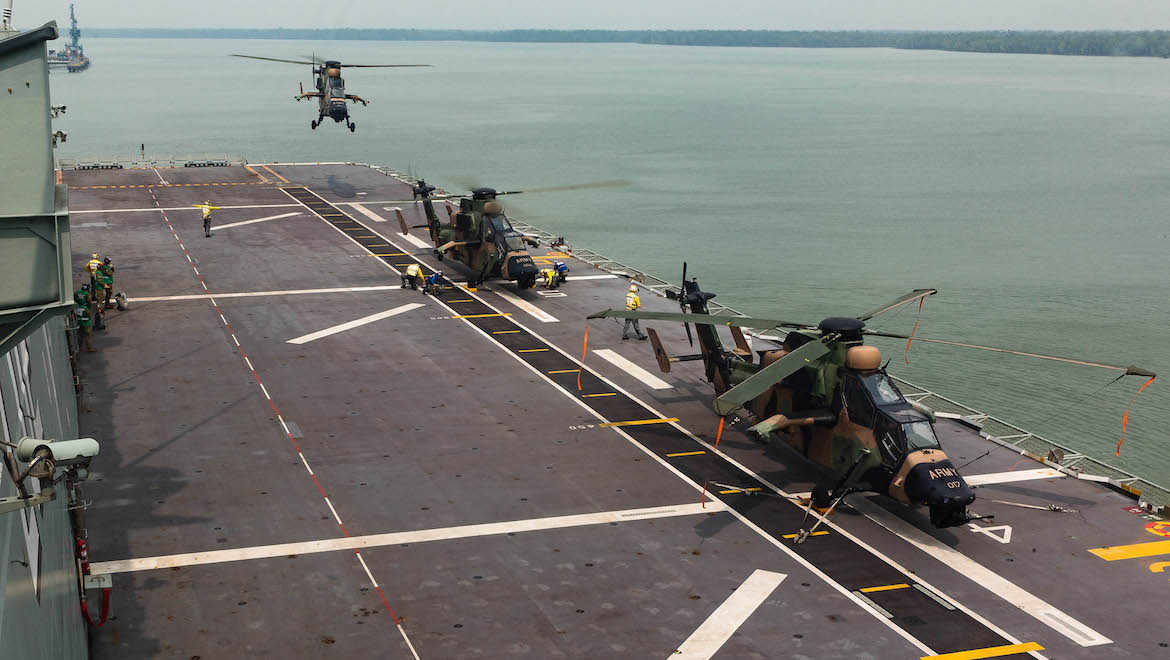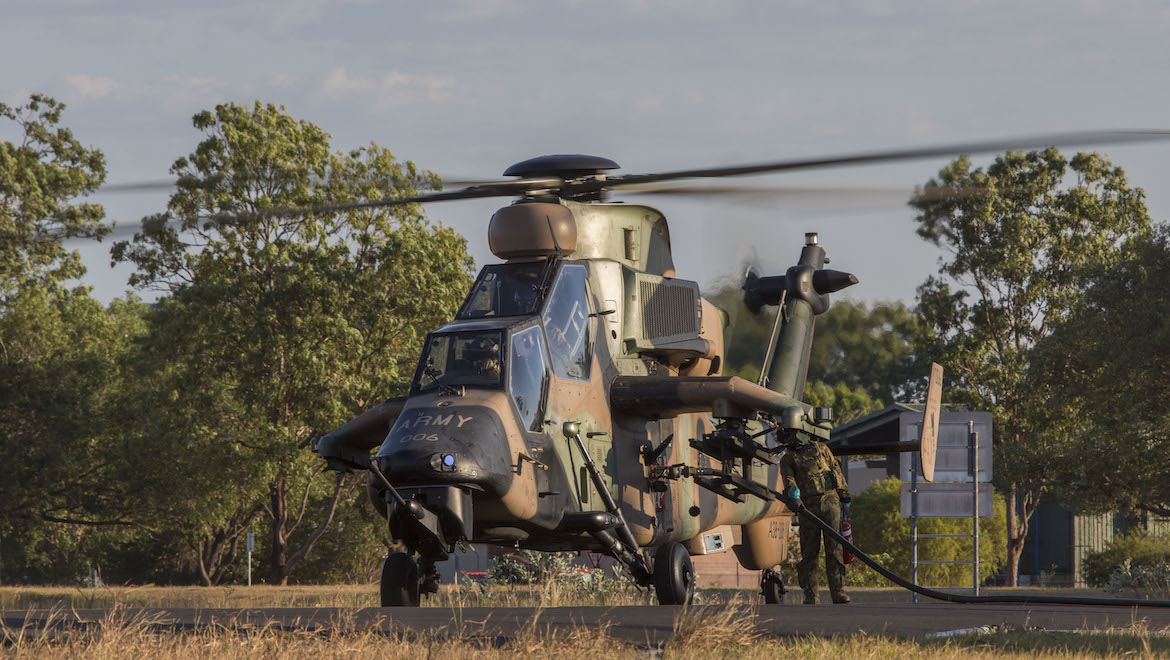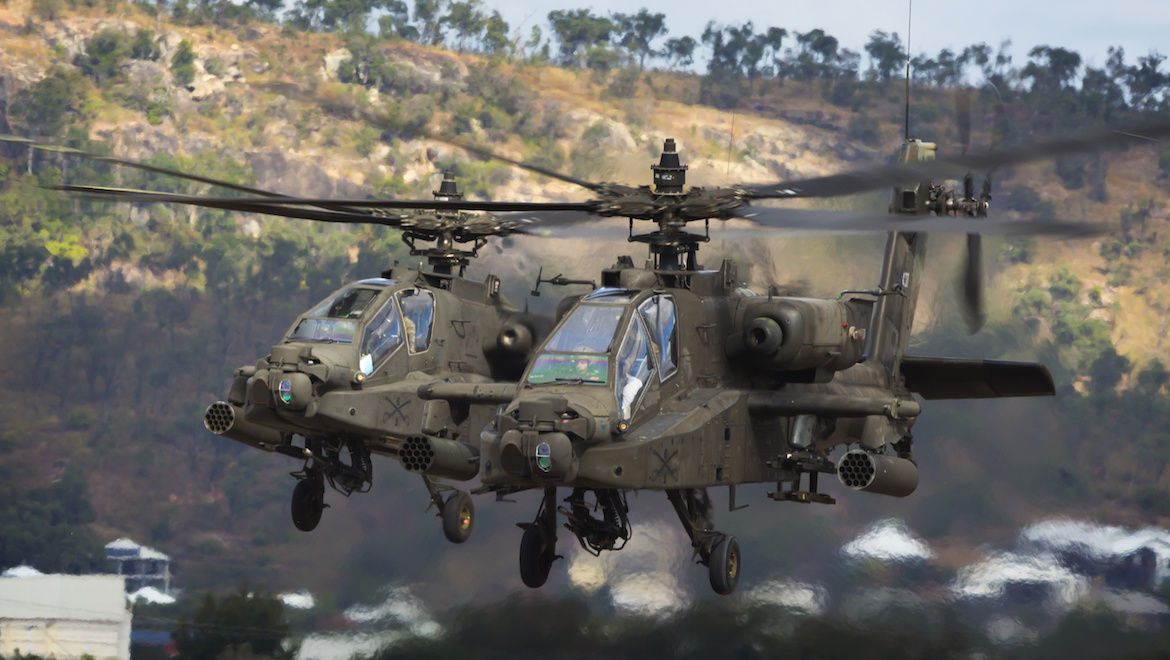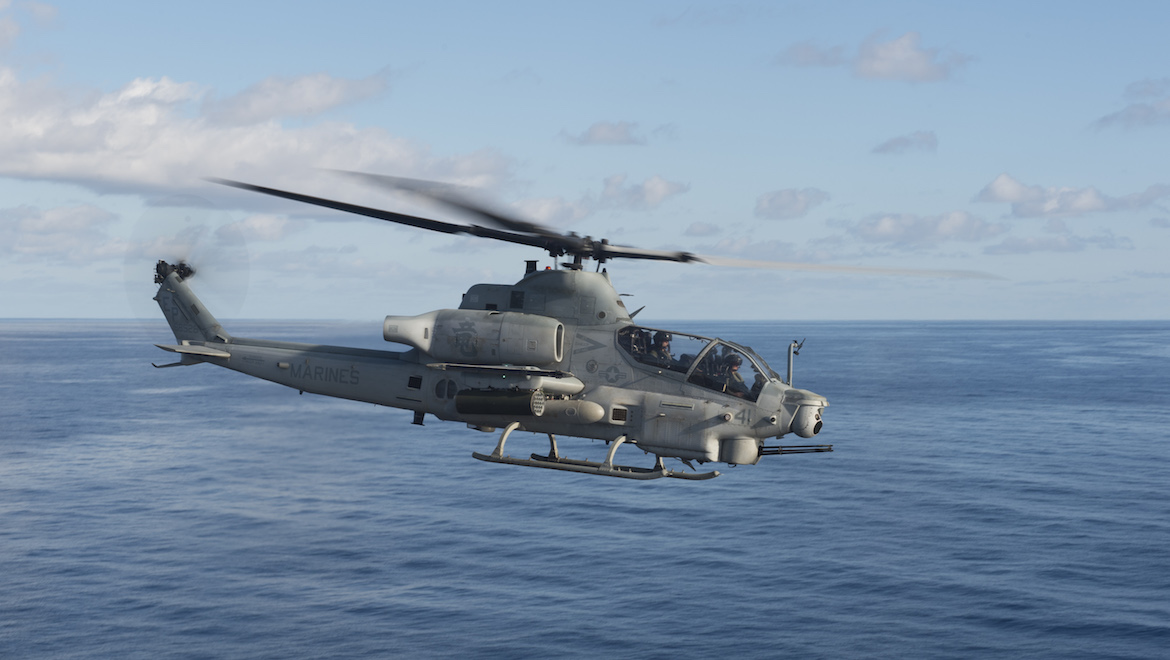
HMAS Canberra. (Defence)
Airbus Helicopters has proposed a mid-life upgrade of the Australian Army’s current Tiger ARH fleet in response to the Commonwealth’s request for information (RFI) to the Project LAND 4503 armed reconnaissance helicopter replacement program.
The Airbus proposal was announced on Friday, the closing date for submissions from industry.
Project LAND 4503 sought a total of 29 airframes to replace the 22 Tigers. It specified that 24 aircraft would be operational at a single location and five airframes will be assigned to training.
Designed to “deliver armed reconnaissance efforts in close and deep contested battlespace”, the RFI called for an initial operational capability (IOC) of one squadron of 12 aircraft in 2026, and a fully operational capability (FOC) to follow in 2028.
It states that at IOC Army would be able to operationally deploy a troop of four aircraft. At FOC, Army would be capable of generating 12 aircraft for deployment while maintaining a training system of five aircraft.
Australian Aviation‘s sister publication ADBR initially understood an upgraded Tiger was unlikely to be considered as a contender for LAND 4503, as the language used in the 2016 Defence White paper and subsequent anecdotal comments by some senior Defence and political leaders suggested Tiger was unloved and unwanted.
“It’s been a challenge,” Airbus Australia Pacific Managing Director and Head of Country Andrew Mathewson told ADBR.
“Tiger is performing very well, but it’s operating in Darwin. It is not seen every day – not only by the general public and by politicians, it’s not even seen every day by the normal members of army.
“It’s only on those major exercises.
“I’ve been delighted to see just how positive though the customer has been, and they’ve been really open from a social media perspective, and making public comments about the performance of Tiger, the contemporary Tiger.
“But, as you know, it takes some time to change the reputation of a product. And we’ve seen that on other campaigns around the great work that’s been done on supporting and delivering that capability. So we’re doing our best to get the truth out there.”

Selected in December 2001 to fulfil Army’s AIR 87 requirement under a then $1.1bn acquisition contract, the first two Tigers were accepted by the Commonwealth in December 2004 with the last of 22 aircraft delivered in late 2011.
In April 2016 the Tiger ARH finally achieved a full operational capability (FOC), some seven years later than planned.
Despite the negative language which evolved from poor aircraft availability and high sustainment costs and an adverse Australian National Audit Office (ANAO) report, Airbus Helicopters has continued to develop the aircraft, and has proposed a number of capability and performance enhancements.
In Europe, the company was implementing Tiger Mark II upgrades for the French Army’s HAP Tiger, the version most common to Australia’s ARH variant. The Mark II will see the addition of new Thales-developed laser-guided rockets, as well as upgrades to the helicopter’s GPS receiver and CRPA antenna system.
Meanwhile, a more comprehensive Tiger Mark III upgrade program was launched through the European Organisation Conjointe de Coopération en Matière d’Armement (Organisation for Joint Armament Co-operation, or OCCAR) with member nations France, Germany and Spain. OCCAR had tried in vain throughout 2016 and 2017 to get a commitment from Australia to join the Mark III development effort.
While the definition of the Mark III upgrade was yet to be finalised, the program was working with Thales and MDBA to enhance the Tiger’s avionics and mission systems, and to develop a new common air-to-surface missile to replace the current AGM-114 Hellfire and Rafael Spike systems.
While Mathewson would not be drawn on any specific enhancements the company was offering for Tiger in its RFI, he did submit it would involve a mid-life upgrade, all of which would be performed in Australia at Airbus’s Pinkenba facility in Brisbane.
“We feel that we’re in a very positive position because Tiger simply isn’t in the same place that it was at the time that the White Paper was written in 2016,” Mathewson said.
“Its improved performance means our customers are happy, and the cost has been reduced, so we’re hopeful that we can convince our customer and government that Tiger is the best product to continue to operate out into the 2040s.
“The Commonwealth is after a mature system, they make that very, very clear in their RFI. So everything we’re offering is a proven system with low risk. We need to do a mid-life type extension, that’s a whole range of engineering work, of course. Tiger has been flying in Australia since 2004, and as part of the upgrade proposal that we have, is to extend the life of the product out into the 2040s.
“We see ourselves as the perfect bridging capability to whatever is the next capability that Defence would consider. And publicly, the indicators are that is likely to be the future vertical lift (FVL) capability. So for us, that would mean extending Tiger by a further 15 years beyond 2025.
“From a value for money perspective, that puts us in a great position, because any other alternative capability to introduce it, effectively it would only just be being matured in the early 2030s to be taken out of service in the late 2030s. To my mind it doesn’t make a great deal of sense from a value-for-money perspective.”
Those alternatives include the Boeing AH-64E Guardian Apache, and the Bell AH-1Z Zulu “Viper”.


Both the AH-64E and the AH-1Z were available now, and neatly fit LAND 4503’s published schedule. They were known and proven capabilities, and fully interoperable with US and other forces in the region. But both offer little in terms of innovation, capability co-development and Australian industry participation, and anecdotal reports suggested neither could match Tiger’s agility and endurance.
But if Defence were to consider a more extensive upgrade to Tiger to allow it to remain in service into the 2030s, then more advanced and innovative replacement options such as FVL may come into play.
Most visible of these were new generation systems under development for the US Army’s FARA competitive program to replace the Bell OH-58D Kiowa Warrior armed scout helicopter which was retired in 2017, a key element of that service’s all-encompassing FVL program.
In late April, the US Army Combat Capabilities Development Command Aviation and Missile Center’s Aviation Development Directorate advised that the FARA program was tracking a few months ahead of schedule, and that prototype agreements had been reached with industry.
The five agreements were awarded to a teaming of AVX Aircraft Co and L3 Communications Integrated Systems with a derivative of AVX’s Joint Multi-Role (JMR) aircraft; Bell Helicopter with a solution based on its conventional 525 Relentless; Sikorsky with a development of the S-97 Raider; Boeing with an as-yet undeclared contender but thought to be the AH-64E Block 2 Compound; and Karem Aircraft with a mystery design.
Since then, Karem has announced it has teamed with Northrop Grumman and Raytheon to offer a design based on Karem’s Optimum Speed Tiltrotor (OSTR) technology.
The US Army plans to have FARA prototypes flying in 2023, and to make a production decision in 2028, although this seems to be overly ambitious for such a developmental program.
VIDEO: A look at the Tiger at the Indo-Pacific Endeavour 2019 exercises from the Australian Army’s YouTube channel.
The June 2019 edition of Australian Aviation included a feature story on the Australian Army’s Tiger ARH. That story can be read here.












